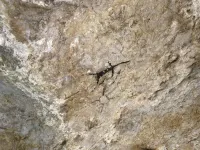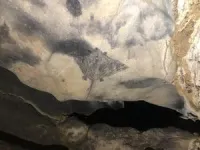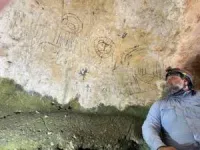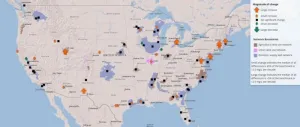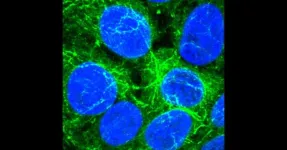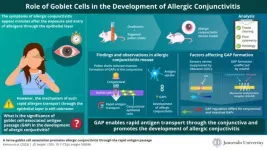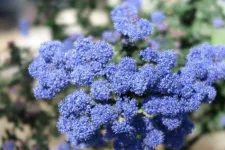(Press-News.org) 17 October 2023
The Geological Society of America
Release No. 23-40
Contact: Justin Samuel
+1-303-357-1026
jsamuel@geosociety.org
For Immediate Release
Leer en español.
Contributed by Sarah Derouin
Pittsburgh, Pa., USA: In the karstic caves of Puerto Rico, cave art paints the rock walls. Previous research has assigned ages to this art based on the ages of nearby archaeological artifacts within the caves, but these ages are relative and may not reflect the true timing of the art creation.
Now, a new study to be presented Wednesday at the Geological Society of America’s GSA Connects 2023 meeting shows that researchers have refined the age of this rupestrian art by dating the pigment in the drawings. Angel Acosta-Colon, a geophysicist at University of Puerto Rico (UPR) at Arecibo, will present the findings.
In Puerto Rican caves, there are three types of art: petroglyphs (carved into the rock), pyroglyphs (drawn from the burnt remnants of objects), and pictographs, or cave drawings. Acosta-Colon says these pictograph drawings are in organic black material, perfect for radiocarbon dating.
Acosta-Colon and his colleague Reniel Rodríguez, an archaeologist at UPR Utuado, visited 11 different caves on La Isla Grande, the big island of the Puerto Rican archipelago. From these caves, they sampled 61 pigments in pictographic art.
The researchers were thoughtful about which art to sample, sampling art that is commonly seen and not unique. “[The pictographs] are not an infinite resource—they are limited,” explains Acosta-Colon. “So if we touch one, we touch it forever and for the future generations, we are not allowing the pleasure of seeing what we see.”
They were also conservative about how much of the material they collected, as sampling destroys a small area of the art. Acosta-Colon says that they take 1 to 2 mg samples from the black markings on cave walls for their analyses.
They ran the microsamples through the Center for Applied Isotope Studies (AIS) at the University of Georgia to get carbon-14 ages for the artwork. The earliest pictographs of abstract, geometrical shapes were dated to ca. 700–400 BCE, coinciding with the Archaic Age.
“That is very important to us because when the European Invasion came to Puerto Rico, they put in a document that our precolonial population was only there for 400 to 500 years,” says Acosta-Colon. “So this proves that we were here [thousands] of years before the European Invasion, and that is documented in science, not context archeology.”
They found that more anthropological-type drawings—with simple shapes of human bodies—were drawn between 200 and 400 CE. “We have gaps of time and that's interesting because we don't know what happened,” says Acosta-Colon, adding that they could fill those gaps with more sampling around the island.
The research team also found more detailed human and animal drawings that were created between 700 and 800 CE. These types of drawings continued throughout the next century, extending through European colonization (around 1500 CE), and include images of horses, ships, and other animals.
Within the array of animals, they discovered a particularly unusual find. “We have an image that looks like a lion—but in Puerto Rico, we don’t have lions,” says Acosta-Colon. When he and Rodriguez considered who could have seen a lion, they thought about the slaves that were brought to the island by the Spanish.
The idea, he notes, is controversial. “But the age of the art is around 1500,” he says. “We have data to corroborate what, I think, is one of the first slave art in caves in Puerto Rico.”
Understanding when these pictographs were created helps explain the history of the Puerto Rican people, says Acosta-Colon. “Normally we get the European history version of Puerto Rico, but this is direct evidence that the story in Puerto Rico didn’t start with the European Invasion, it started much, much earlier in history,” he notes.
He believes that studying more cave art sites may push back the human history record to 5000 BCE. This art, along with archeological finds, can reconstruct the “history of our people, from Archaic people, to the Taino people to the pre-Columbian time.
Radiocarbon dating of cave pictographic rock art in Puerto Rico
Contact: Angel Acosta-Colon, angel.acosta2@upr.edu
208: D11. Recent Advances in Geoarchaeology: Studies from Asia, Europe and the Americas
Wed., 18 Oct. 2023, 10:20–10:35 a.m.
The Geological Society of America (https://www.geosociety.org) unites a diverse community of geoscientists in a common purpose to study the mysteries of our planet (and beyond) and share scientific findings. Members and friends around the world, from academia, government, and industry, participate in GSA meetings, publications, and programs at all career levels, to foster professional excellence. GSA values and supports inclusion through cooperative research, public dialogue on earth issues, science education, and the application of geoscience in the service of humankind.
###
END
New dating of cave art reveals history of Puerto Rican people
New research presented at GSA Connects 2023
2023-10-17
ELSE PRESS RELEASES FROM THIS DATE:
U.S. groundwater is getting saltier—what that means for infrastructure, ecosystems, and human health
2023-10-17
17 October 2023
The Geological Society of America
Release No. 23-41
Contact: Justin Samuel
+1-303-357-1026
jsamuel@geosociety.org
For Immediate Release
Contributed by Sarah Derouin
Pittsburgh, Pa., USA: Scientists from the U.S. Geological Survey (USGS) have been monitoring groundwater quality in wells across the country for more than three decades, looking for harmful chemicals or residual substances that may cause harm to ecosystems or humans. In all, they have measured up to 500 chemical constituents, including major ions, metals, pesticides, volatile organic compounds, fertilizers, and radionuclides.
Of ...
Pathogen that plagues food processing plants eradicated by blue light
2023-10-17
Washington, D.C. – Blue light kills both dried cells and biofilms of the pathogen Listeria monocytogenes, a frequent contaminant of food processing facilities. Demise of L. monocytogenes occurred quickest when cells or biofilms were placed on polystyrene, a widely used, transparent form of plastic. The research is published in Applied and Environmental Microbiology, a journal of the American Society for Microbiology.
“These results contribute to advancing our understanding of the potential of blue light to treat inert surfaces contaminated with L. monocytogenes,” said corresponding author ...
Public health interventions prevented transmission within BU most SARS-CoV-2 cases
2023-10-17
(Boston)— SARS-CoV-2, the causative agent of COVID-19, began impacting the U.S. in March 2020 with many schools and universities shifting to remote education by early April 2020 in response to the public health emergency. Despite public health interventions (increased ventilation, masking policies, surveillance testing, contact tracing of confirmed cases and quarantine procedures for infected students, faculty and staff) there were still concerns that institutes of higher education would be a hotbed of transmission, including transmission from students into surrounding communities.
But, were these fears warranted?
A ...
CastleVax Inc. receives BARDA project NextGen award valued at up to $338 million to advance intranasal NDV-based COVID-19 booster vaccine into phase 2b clinical efficacy testing
2023-10-17
CastleVax, a clinical stage vaccine platform company, has received a Project NexGen award valued at up to $338 million from the Biomedical Advanced Research and Development Authority (BARDA), part of the Administration for Strategic Preparedness and Response (ASPR) in the U.S. Department of Health and Human Services (HHS), to support the development of a next-generation, booster vaccine to protect against COVID-19 for years to come. The initial phase of the award provides approximately $8.5 million to plan a Phase 2b clinical trial that would compare CastleVax’s vaccine to currently ...
New cancer therapy target stops tumor cells from sharing resources
2023-10-17
Researchers at University of California San Diego have discovered a process in which liver cells share molecules via vesicle exchange in order to multiply under conditions that would ordinarily suppress cell proliferation. They also found evidence that this process occurs in various types of cancer cells, paving the way for a new approach to tackling treatment resistance in cancer. The findings were published on October 17, 2023 in eLife.
“Understanding cell proliferation is a fundamental issue in both cancer research and biomedical science as a whole,” said Gen-Sheng Feng, PhD, a professor of pathology at UC San Diego School of Medicine and of molecular biology ...
International team reveals source of largest ever Mars quake
2023-10-17
A global team of scientists have announced the results of an unprecedented collaboration to search for the source of the largest ever seismic event recorded on Mars. The study, led by the University of Oxford, rules out a meteorite impact, suggesting instead that the quake was the result of enormous tectonic forces within Mars’ crust.
The quake, which had a magnitude of 4.7 and caused vibrations to reverberate through the planet for at least six hours, was recorded by NASA’s InSight lander on May 4 2022. ...
The dark side of the American lawn
2023-10-17
The American residential lawn is, for many, an iconic landscape and about half of homeowners in the US use fertilizer to keep their yards green and lush. Some proportion of the nitrogen in this fertilizer enters the broader environment, with negative consequences including algal blooms and deoxygenated waters. Peter Groffman and colleagues studied residential landscapes in the Baltimore, Maryland metropolitan area, which drains to the Chesapeake Bay, seeking to identify locations (hotspots) or times (hot moments) with disproportionately high rates of nitrogen export. The authors went to lawns in exurban, ...
New study sheds light on the developmental mechanism of allergic conjunctivitis
2023-10-17
When it comes to eye allergies, the transition from allergen contact to bothersome symptoms has always been quick, appearing within a span of a few minutes. The initial stage of allergic conjunctivitis involves the penetration of allergen through the epithelial cell layer (cells covering the outer surface of the body). However, the exact mechanism underlying the rapid allergen transfer has remained a mystery so far.
Fortunately, in a new ground-breaking study published in the journal JCI Insight on October 11, 2023, researchers from Juntendo ...
Western University researchers reveal link between Alzheimer’s and sex hormones
2023-10-17
LONDON, ON., CA:
Alzheimer’s disease disproportionately affects women, who represent about two-thirds of those diagnosed with the late-onset type of the disease.
Previous research has shown Alzheimer’s is also more severe and progresses more rapidly in women, and women with Alzheimer’s experience a steeper cognitive decline – loss of memory, attention, and the ability to communicate and make decisions – compared to men with the disease.
The biological bases for these differences between men and women with Alzheimer’s disease are not well understood. ...
How to help save plants from extinction
2023-10-17
Now is the time to identify the conditions that cause plants to die. Doing so will allow us to better protect plants by choosing conservation targets more strategically, UC Riverside botanists argue in a new paper.
Published in the Oxford Academic journal Conservation Physiology, the paper demonstrates how scientists can learn the limits past which plants’ vital functions shut down, and makes the case that not doing so is a mistake in this era of increasing drought and wildfires.
“We can measure the amount of water loss plants ...
LAST 30 PRESS RELEASES:
University of Cincinnati experts present research at annual hematology event
ASH 2025: Antibody therapy eradicates traces of multiple myeloma in preliminary trial
ASH 2025: AI uncovers how DNA architecture failures trigger blood cancer
ASH 2025: New study shows that patients can safely receive stem cell transplants from mismatched, unrelated donors
Protective regimen allows successful stem cell transplant even without close genetic match between donor and recipient
Continuous and fixed-duration treatments result in similar outcomes for CLL
Measurable residual disease shows strong potential as an early indicator of survival in patients with acute myeloid leukemia
Chemotherapy and radiation are comparable as pre-transplant conditioning for patients with b-acute lymphoblastic leukemia who have no measurable residual disease
Roughly one-third of families with children being treated for leukemia struggle to pay living expenses
Quality improvement project results in increased screening and treatment for iron deficiency in pregnancy
IV iron improves survival, increases hemoglobin in hospitalized patients with iron-deficiency anemia and an acute infection
Black patients with acute myeloid leukemia are younger at diagnosis and experience poorer survival outcomes than White patients
Emergency departments fall short on delivering timely treatment for sickle cell pain
Study shows no clear evidence of harm from hydroxyurea use during pregnancy
Long-term outlook is positive for most after hematopoietic cell transplant for sickle cell disease
Study offers real-world data on commercial implementation of gene therapies for sickle cell disease and beta thalassemia
Early results suggest exa-cel gene therapy works well in children
NTIDE: Disability employment holds steady after data hiatus
Social lives of viruses affect antiviral resistance
Dose of psilocybin, dash of rabies point to treatment for depression
Helping health care providers navigate social, political, and legal barriers to patient care
Barrow Neurological Institute, University of Calgary study urges “major change” to migraine treatment in Emergency Departments
Using smartphones to improve disaster search and rescue
Robust new photocatalyst paves the way for cleaner hydrogen peroxide production and greener chemical manufacturing
Ultrafast material captures toxic PFAS at record speed and capacity
Plant phenolic acids supercharge old antibiotics against multidrug resistant E. coli
UNC-Chapel Hill study shows AI can dramatically speed up digitizing natural history collections
OYE Therapeutics closes $5M convertible note round, advancing toward clinical development
Membrane ‘neighborhood’ helps transporter protein regulate cell signaling
Naval aviator turned NPS doctoral student earns national recognition for applied quantum research
[Press-News.org] New dating of cave art reveals history of Puerto Rican peopleNew research presented at GSA Connects 2023
